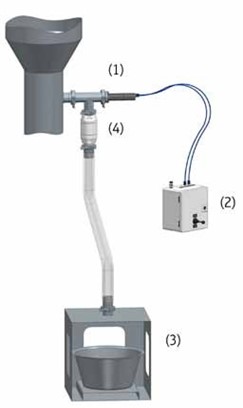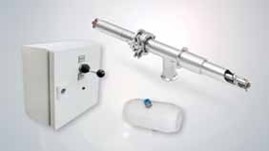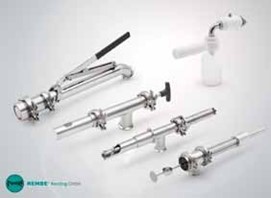Sampling from the receipt of the goods to the final inspection
Whether it’s in the cement, chemical or feed industry, reliable quality assurance requires companies to constantly monitor the quality standards, and to guarantee a comprehensive traceability. The customers are demanding and expect full compliance with regulations and quality characteristics at all times. But prior control of the substance to be used is an essential factor to ensure the desired quality, especially in the light of processes with ever-increasing complexity. Depending on the product or process management, dangers may otherwise arise for people and the environment.
![[Translate to English:]](/fileadmin/REMBE_Kersting/Blog/Probenahme-Eingang-Endkontrolle/Probenahme-eingang-endkontr.jpg)

(1) Sample extraction with pneumatically controlled auger sampler 1 pneumatic auger sampler <br> 2 joystick <br> 3 sample collection container <br> 4 quench valve<br>
1 Sampling and quality assurance
The bulk goods experts from REMBE® Kersting GmbH enable reliable quality assurance through the use of sampling devices in the following areas:
» Check in the goods receipt area
» Precise monitoring and control of production rocesses
» Output control of the final products
An important component of the quality assurance and process analysis is the representative sampling as a foundation for subsequent laboratory stud- ies. Today’s laboratory analysis technology is able to detect nearly every component within a product. However, a sophisticated analytical technique alone is not a guarantee for reliable quality control, since the result of the examination only applies to the tested sample. For an accurate statement about the property of the total quantity to be taken, sam- pling and preparation as well as analysis tech- niques must be precisely coordinated.
2 Representative sampling
A representative sample extraction is the sampling of a partial amount from an overall quantity, where- by the partial amount can be regarded as representa- tive of the overall quantity. In the sample, the same distribution of properties must be present as in the total quantity. The sampling devices used by the bulk goods experts from REMBE® Kersting strongly depends on which product properties are to be examined and in which process step the sampling is conducted. After defining the properties to be examined, it is neces- sary to find a method with which samples can be obtained reproducibly.
3 Use of the sampling systems
In several cement plants, the bulk goods experts from REMBE® Kersting utilized automated in-line auger sampler to provide the plant operators with a simple option to extract reference samples when unloading the cement during the delivery. This will evidence the quality of the batch and can be used to counter unjustified customer complaints (Figure 1 and 2).
A pneumatic auger sampler (1) is used for the sample extraction. It is attached to the downpipe with a weld-on flange and is designed to remain in the process for the long-term. In addition, the use of an auger sampler enables the drawing of any sample quantity. The sampling is controlled with a joystick (2). As a result, the truck driver is in a position to initi- ate the sampling independently. The runtime of the sampling device is freely selectable so that different sample quantities can be extracted. From the auger sampler, the material subse-quently falls into a sample collection container.
This is located in a hermetically sealed box (3). This en- sures that the sample is protected against dust and dirt. After the sampling procedure has been conclud- ed, the reference sample can be removed from the box and then analyzed or stored. Additionally, the sample collection container is separated from the rest of the process by a quench valve (4). This avoids any unwanted process material passing through the sampling device and entering the sample vessel due to fluidizing behavior. The quench valve is also controlled with the joystick controller. It is opened during the sample extraction and remains closed otherwise. This always guarantees a fresh sample extraction.
4 Why automated sampling? Influence of the personnel on the sample extraction
During the manual sample extraction there is a great risk when humans are used as the sampling conducting entity, because in practice assistant personnel is often entrusted with performing the sampling and is often not aware of the significance of this task and/or not sufficiently experienced in handling these types of systems. However, the correct sampling pro- cedure is an important step and can have significant consequences - depending on the result. In order to reduce these sources of error during the sampling, REMBE® Kersting GmbH utilizes automatic Inline-Sampling devices which minimize the influence the employee can exert on the sampling process and thus on the result of the sampling. The properties of the individual sampling devices are adapted to the respective application parameters and material characteristics.
The product range extends from cup sample holders to auger and piston samplers and all the way up to sampling valves. The inline sampling devices from the bulk goods experts from Rembe Kersting meet the following requirements:
» Version: The design and processing are carried out without edges and undercuts, so that no contamination can occur. A carryover contamination is thus effectively avoided
» Control: The sampling devices can be operated in different ways: manually, pneumatically or elec- trically. This has the advantage that they can be easily integrated into the existing process control system and centrally controlled
» Handling: The sampling devices can be operated easily and without extensive prior knowledge. They are also low-maintenance and easy to clean.
The bulk good experts from REMBE® Kersting GmbH are specialized in the production, sales and implementation of sampling devices (Figure 3) in the process industry and provides customers from various industries around the world with professional consulting for the realization of sampling projects.


